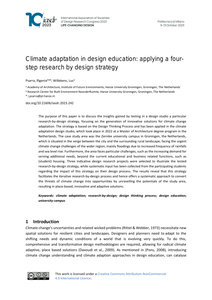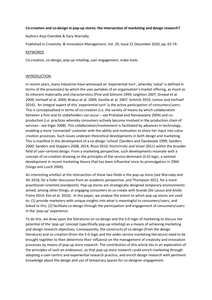Providing users with a sense of place – related to a specific geographic location in which one is situated, or linked to a faraway place, or even giving place-like qualities to virtual spaces such as massively multiplayer online role-playing games – has been deemed central for several forms of digital interactions. In the past decade, studies from human-computer interaction and computer-supported cooperative work have specifically addressed this theme, but the scarcity of works of place specificity focusing expressly on interactive TV suggests a gap in the current research, whereas the latest developments in mobile TV would seem highly coherent with such topic. To contribute to closing this gap, some initial directions are suggested here by pointing at compatible treatments of the notion of place in related fields, for example, the design of pervasive urban games. Game designers and game scholars might provide operational concepts that help understanding the role and the potentialities of places for interactive TV. Two general types of artifacts are selected here: works that are anchored to the experience of faraway places and works that leverage the physical location in which the user is. Their analysis yields three design strategies (experience anchoring, place permeability, and distributed storytelling), offered here as “objects to think with” and to spur further research and design. By pointing at them and at other similar strategies, similarities between digital games, ITV products, and other similar artifacts emerge and allow us to speculatively trace possible future convergences.
LINK
In our research we focus on the architectural characteristics of a location, seen as a precondition to appeal to the imaginative power of learners that plays a part in satisfying their (presupposed) spiritual hunger and longings for a better world. The concepts space, nonplace, and place, in their relation to the concepts place attachment and sense of place are central in our research. In written and videotaped texts, pupils tell about their attachment to places and sense of place. The preliminary analysis of the texts of the pupils shows that friends and teacher(s) occupy a central place in these pupils’ place attachment and sense of place.
DOCUMENT
Academic design research often fails to contribute to design practice. This dissertation explores how design research collaborations can provide knowledge that design professionals will use in practice. The research shows that design professionals are not addressed as an important audience between the many audiences of collaborative research projects. The research provides insight in the learning process by design professionals in design research collaborations and it identifies opportunities for even more learning. It shows that design professionals can learn about more than designing, but also about application domains or project organization.
DOCUMENT

This investigation explores relations between 1) a theory of human cognition, called Embodied Cognition, 2) the design of interactive systems and 3) the practice of ‘creative group meetings’ (of which the so-called ‘brainstorm’ is perhaps the best-known example). The investigation is one of Research-through-Design (Overbeeke et al., 2006). This means that, together with students and external stakeholders, I designed two interactive prototypes. Both systems contain a ‘mix’ of both physical and digital forms. Both are designed to be tools in creative meeting sessions, or brainstorms. The tools are meant to form a natural, element in the physical meeting space. The function of these devices is to support the formation of shared insight: that is, the tools should support the process by which participants together, during the activity, get a better grip on the design challenge that they are faced with. Over a series of iterations I reflected on the design process and outcome, and investigated how users interacted with the prototypes.
DOCUMENT

The purpose of this paper is to discuss the insights gained by testing in a design studio a particular research-by-design strategy, focusing on the generation of innovative solutions for climate change adaptation. The strategy is based on the Design Thinking Process and has been applied in the climate adaptation design studio, which took place in 2022 at a Master of Architecture degree program in the Netherlands. The case study area was the Zernike university campus in Groningen, the Netherlands, which is situated in the verge between the city and the surrounding rural landscape, facing the urgent climate change challenges of the wider region, mainly floodings due to increased frequency of rainfalls and sea level rise. Furthermore, the area faces particular challenges, such as the increasing demand for serving additional needs, beyond the current educational and business related functions, such as (student) housing. Three indicative design research projects were selected to illustrate the tested research-by-design strategy, while systematic input has been collected from the participating students regarding the impact of this strategy on their design process. The results reveal that this strategy facilitates the iterative research-by-design process and hence offers a systematic approach to convert the threats of climate change into opportunities by unravelling the potentials of the study area, resulting in place-based, innovative and adaptive solutions.
DOCUMENT

In this paper we explore the influence of the physical and social environment (the design space) son the formation of shared understanding in multidisciplinary design teams. We concentrate on the creative design meeting as a microenvironment for studying processes of design communication. Our applied research context entails the design of mixed physical–digital interactive systems supporting design meetings. Informed by theories of embodiment that have recently gained interest in cognitive science, we focus on the role of interactive “traces,” representational artifacts both created and used by participants as scaffolds for creating shared understanding. Our research through design approach resulted in two prototypes that form two concrete proposals of how the environment may scaffold shared understanding in design meetings. In several user studies we observed users working with our systems in natural contexts. Our analysis reveals how an ensemble of ongoing social as well as physical interactions, scaffolded by the interactive environment, grounds the formation of shared understanding in teams. We discuss implications for designing collaborative tools and for design communication theory in general.
MULTIFILE

The purpose is to give an overview of the extent, range and nature of existing definitions of the concept ‘ageing in place’. Providing such an overview may be helpful, for policy makers, researchers, communities and service providers, to make sense of the versatility and uses of the concept, and allow the improvement and increase the success of efforts to contribute to the quality of life of older people. The overview was created using Arksey and O’Malley’s scoping review methodology. Out of 3,692 retrieved articles, 34 met the inclusion criteria. These studies concentrate on the following five key themes concerning ‘ageing in place’: ‘ageing in place’ in relation to place, to social networks, to support, to technology and to personal characteristics. Each of these key themes consists of other aspects, like physical place and attachment to place for the keyword place. This study concludes that the concept ‘ageing in place’ is broad and can be viewed from different (i.e. five) key themes. A more thorough understanding of ‘ageing in place’ provides knowledge about the existing key themes and aspects. These findings might provide practical support for professionals and governments when they develop their policies about ‘ageing in place’ integrally and to develop fit policies.
DOCUMENT

There has probably never been such an intense debate about the layout of the countryside as the one that is currently raging. There are serious concerns about the landscape, which is being rapidly transformed by urbanization and everything associated with this process, and not only in the Netherlands but also far beyond its borders. Everyone has something to say in this society-wide debate, from local to national governments, from environmental factions to the road-user's lobby, and from those who are professionally involved to concerned private parties. In many cases it is a battle between idealized images and economic models, between agricultural reality and urban park landscapes, between ecological concerns and mobility. This issue of OASE explores the potential significance of architectonic design for transformation processes on the regional scale. Besides considering the instruments that are available to the designer to fulfil this task, the authors also consider how the design can exercise a 'positive' influence on such processes. The various contributions shed light on the potential significance of territory in contemporary design practice and offer critical reflection on the topical discourse that has evolved over recent years.
DOCUMENT

Co-creation as a concept and process has been prominent in both marketing and design research over the past ten years. Referring respectively to the active collaboration of firms with their stakeholders in value creation, or to the participation of design users in the design research process, there has arguably been little common discourse between these academic disciplines. This article seeks to redress this deficiency by connecting marketing and design research together—and particularly the concepts of co-creation and co-design—to advance theory and broaden the scope of applied research into the topic. It does this by elaborating the notion of the pop-up store as temporary place of consumer/user engagement, to build common ground for theory and experimentation in terms of allowing marketers insight into what is meaningful to consumers and in terms of facilitating co-design. The article describes two case studies, which outline how this can occur and concludes by proposing principles and an agenda for future marketing/design pop-up research. This is the peer reviewed version of the following article: Overdiek A. & Warnaby G. (2020), "Co-creation and co-design in pop-up stores: the intersection of marketing and design research?", Creativity & Innovation Management, Vol. 29, Issue S1, pp. 63-74, which has been published in final form at https://doi.org/10.1111/caim.12373. This article may be used for non-commercial purposes in accordance with Wiley Terms and Conditions for Use of Self-Archived Versions. LinkedIn: https://nl.linkedin.com/in/overdiek12345
MULTIFILE

Background: Most studies on birth settings investigate the association between planned place of birth at the start of labor and birth outcomes and intervention rates. To optimize maternity care it also is important to pay attention to the entire process of pregnancy and childbirth. This study explores the association between the initial preferred place of birth and model of care, and the course of pregnancy and labor in low-risk nulliparous women in the Netherlands. Methods: As part of a Dutch prospective cohort study (2007–2011), we compared medical indications during pregnancy and birth outcomes of 576 women who initially preferred a home birth (n = 226), a midwife-led hospital birth (n = 168) or an obstetrician-led hospital birth (n = 182). Data were obtained by a questionnaire before 20 weeks of gestation and by medical records. Analyses were performed according to the initial preferred place of birth. Results: Low-risk nulliparous women who preferred a home birth with midwife-led care were less likely to be diagnosed with a medical indication during pregnancy compared to women who preferred a birth with obstetrician-led care (OR 0.41 95% CI 0.25-0.66). Preferring a birth with midwife-led care – both at home and in hospital - was associated with lower odds of induced labor (OR 0.51 95% CI 0.28-0.95 respectively OR 0.42 95% CI 0.21-0.85) and epidural analgesia (OR 0.32 95% CI 0.18-0.56 respectively OR 0.34 95% CI 0.19-0.62) compared to preferring a birth with obstetrician-led care. In addition, women who preferred a home birth were less likely to experience augmentation of labor (OR 0.54 95% CI 0.32-0.93) and narcotic analgesia (OR 0.41 95% CI 0.21-0.79) compared to women who preferred a birth with obstetrician-led care. We observed no significant association between preferred place of birth and mode of birth. Conclusions: Nulliparous women who initially preferred a home birth were less likely to be diagnosed with a medical indication during pregnancy. Women who initially preferred a birth with midwife-led care – both at home and in hospital – experienced lower rates of interventions during labor. Although some differences can be attributed to the model of care, we suggest that characteristics and attitudes of women themselves also play an important role.
MULTIFILE
